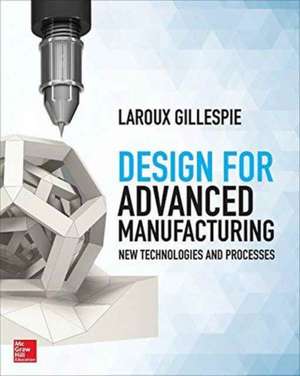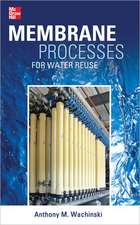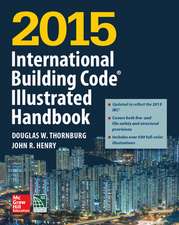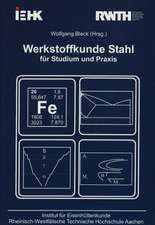Design for Advanced Manufacturing: Technologies and Processes
Autor LaRoux Gillespieen Limba Engleză Hardback – 16 apr 2017
Cutting-edge coverage of the new processes, materials, and technologies that are revolutionizing the manufacturing industry
Expertly edited by a past president of the Society of Manufacturing Engineers, this state-of-the-art resource picks up where the bestselling Design for Manufacturability Handbook left off. Within its pages, readers will find detailed, clearly written coverage of the technologies, and processes that have been developed and adopted in the manufacturing industry over the past sixteen years. More than this, the book also includes hard-to-find technical guidance and application information that can be used on the job to actually apply these cutting-edge processes and technologies in a real-world setting. Essential for manufacturing engineers and designers, Design for Advanced Manufacturing is enhanced by a host of international contributors, making the book a true global resource.
• Information on the latest technologies and processes such as 3-D printing, nanotechnology, laser cutting, prototyping, additive manufacturing, and CAD/CAM software tools
Preț: 587.63 lei
Preț vechi: 844.20 lei
-30% Nou
Puncte Express: 881
Preț estimativ în valută:
112.46€ • 116.17$ • 93.59£
112.46€ • 116.17$ • 93.59£
Carte disponibilă
Livrare economică 06-12 martie
Preluare comenzi: 021 569.72.76
Specificații
ISBN-13: 9781259587450
ISBN-10: 1259587452
Pagini: 624
Dimensiuni: 185 x 241 x 38 mm
Greutate: 1.28 kg
Editura: McGraw Hill Education
Colecția McGraw-Hill
Locul publicării:United States
ISBN-10: 1259587452
Pagini: 624
Dimensiuni: 185 x 241 x 38 mm
Greutate: 1.28 kg
Editura: McGraw Hill Education
Colecția McGraw-Hill
Locul publicării:United States
Cuprins
Introduction
Part 1 Manufacturing with Lasers
1.1 Overview of Laser Manufacturing Processes
Reference
1.2 Laser Cutting
Materials
Equipment Capabilities
Design Considerations
1.3 Laser Surface Texturing
Process Physics
Why Use Laser Texturing?
Design Considerations
Material Suitability
Laser versus Electron Beam
Continuous versus Pulsed Operation
Surface Topography
Polishing Limitations
Structuring Limitations
Cost
References
1.4 Laser Ablation for Cleaning, Decoating, and Surface Preparation
Basic Science of Laser Ablation
Surface Preparation in Manufacturing
Implementation Considerations
Applications Where Laser Ablation Works Best
Applications Where Laser Ablation May or May Not Bring Important Benefits
Manual versus Robotic Laser Ablation
Precautions and Safety
1.5 Laser Hardening
Process
Applicable Lasers
Laser Hardening Materials
Grain Size
Hardening Process Comparisons
Application Examples
Laser Hardening of Dies and Tooling
Laser Hardening of Gears
Laser Hardening of Machine Parts
Laser Hardening of Cast Iron
References
1.6 Laser Welding of Metals
Applications
Equipment
Materials
Design Considerations
References
1.7 Laser Welding of Plastics
Contour Welding
Simultaneous
Quasi-Simultaneous
Mask
Line
Unique Variations
Applications
Materials Selection
Joint Design
Design Considerations
References
1.8 Designing for Laser Soldering
The Process
Typical Characteristics and Applications
Economics
Suitable Materials
Design Recommendations
Through-Hole Pad Design
Lap Joint Pad Design
Connector Selection
Fixturing
Lead-to-Hole Ratio
1.9 Design for Laser Cladding
The Laser Cladding Process
Laser Cladding and Conventional Welding
Laser Cladding with Powder versus Wire
Laser Cladding with Powder
Laser Cladding with Wire
Applications and Cladding Variables
Filler Materials
Laser Cladding Production Performance
1.10 Laser Marking and Engraving
Laser Marking
Materials That Can Be Marked
Selecting a Laser
Marking Metals
Anneal Marking
Engraving and Etching
Plastic, Glass, Coated, and Paper Marking
Marking on Painted Surfaces
1.11 Laser-Assisted Forming
Laser Forming
Laser-Assisted Forming
Laser-Assisted Micro Forming
References
1.12 Laser Peening
Laser Peening Process
Typical Characteristics and Applications
Residual Stress Magnitude and Depth
Residual Stress Stability
Surface Roughness Effects
Material Properties
Compensating Stresses and Deformation
Common Applications
Economics
General Process Design Considerations
Design Methodology
Pattern Size and Location
Intensity and Coverage
Suitable Materials
Detailed Design Considerations
Variations Based on Supplier
Intensity and Coverage Specification
Patch Size and Location on Drawings
Processing of Thin Sections and Shot Orders
Minimum Thickness
Part 2 Manufacturing with Additive Processes
2.1 Overview of Additive Manufacturing Processes
Overview of Primary Additive Manufacturing Technologies
General Design Considerations for Additive Manufacturing
References
2.2 Binder Jetting
The Process and Materials
Typical Characteristics and Applications
As Bonded
Lightly Sintered
Sintered and Infiltrated
Highly Sintered
Advantages of Binder Jetting
Economics
General Design Considerations
Suitable Materials
Detailed Design Considerations
Wall Thickness
Uniform Wall Thickness
Inside Edges
Interior Holes
Part Connections
2.3 Directed Energy Deposition
Metals
Applications
Design Issues
References
2.4 Material Extrusion
Applications
Considerati
Part 1 Manufacturing with Lasers
1.1 Overview of Laser Manufacturing Processes
Reference
1.2 Laser Cutting
Materials
Equipment Capabilities
Design Considerations
1.3 Laser Surface Texturing
Process Physics
Why Use Laser Texturing?
Design Considerations
Material Suitability
Laser versus Electron Beam
Continuous versus Pulsed Operation
Surface Topography
Polishing Limitations
Structuring Limitations
Cost
References
1.4 Laser Ablation for Cleaning, Decoating, and Surface Preparation
Basic Science of Laser Ablation
Surface Preparation in Manufacturing
Implementation Considerations
Applications Where Laser Ablation Works Best
Applications Where Laser Ablation May or May Not Bring Important Benefits
Manual versus Robotic Laser Ablation
Precautions and Safety
1.5 Laser Hardening
Process
Applicable Lasers
Laser Hardening Materials
Grain Size
Hardening Process Comparisons
Application Examples
Laser Hardening of Dies and Tooling
Laser Hardening of Gears
Laser Hardening of Machine Parts
Laser Hardening of Cast Iron
References
1.6 Laser Welding of Metals
Applications
Equipment
Materials
Design Considerations
References
1.7 Laser Welding of Plastics
Contour Welding
Simultaneous
Quasi-Simultaneous
Mask
Line
Unique Variations
Applications
Materials Selection
Joint Design
Design Considerations
References
1.8 Designing for Laser Soldering
The Process
Typical Characteristics and Applications
Economics
Suitable Materials
Design Recommendations
Through-Hole Pad Design
Lap Joint Pad Design
Connector Selection
Fixturing
Lead-to-Hole Ratio
1.9 Design for Laser Cladding
The Laser Cladding Process
Laser Cladding and Conventional Welding
Laser Cladding with Powder versus Wire
Laser Cladding with Powder
Laser Cladding with Wire
Applications and Cladding Variables
Filler Materials
Laser Cladding Production Performance
1.10 Laser Marking and Engraving
Laser Marking
Materials That Can Be Marked
Selecting a Laser
Marking Metals
Anneal Marking
Engraving and Etching
Plastic, Glass, Coated, and Paper Marking
Marking on Painted Surfaces
1.11 Laser-Assisted Forming
Laser Forming
Laser-Assisted Forming
Laser-Assisted Micro Forming
References
1.12 Laser Peening
Laser Peening Process
Typical Characteristics and Applications
Residual Stress Magnitude and Depth
Residual Stress Stability
Surface Roughness Effects
Material Properties
Compensating Stresses and Deformation
Common Applications
Economics
General Process Design Considerations
Design Methodology
Pattern Size and Location
Intensity and Coverage
Suitable Materials
Detailed Design Considerations
Variations Based on Supplier
Intensity and Coverage Specification
Patch Size and Location on Drawings
Processing of Thin Sections and Shot Orders
Minimum Thickness
Part 2 Manufacturing with Additive Processes
2.1 Overview of Additive Manufacturing Processes
Overview of Primary Additive Manufacturing Technologies
General Design Considerations for Additive Manufacturing
References
2.2 Binder Jetting
The Process and Materials
Typical Characteristics and Applications
As Bonded
Lightly Sintered
Sintered and Infiltrated
Highly Sintered
Advantages of Binder Jetting
Economics
General Design Considerations
Suitable Materials
Detailed Design Considerations
Wall Thickness
Uniform Wall Thickness
Inside Edges
Interior Holes
Part Connections
2.3 Directed Energy Deposition
Metals
Applications
Design Issues
References
2.4 Material Extrusion
Applications
Considerati




